9 Birra Moretti
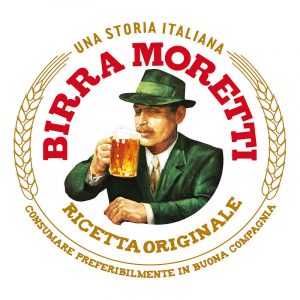
INTRODUCTION
Today, Birra Moretti is known as one of Italy’s most loved and internationally recognized beer brands. It is one of Italy’s oldest operating breweries. For over a hundred years, the pale lager beer produced by Birra Moretti in Udine was largely marketed regionally to citizens of the Friuli region and Northern Italy (Birra Moretti, 2020).
It was not until the late 1980’s that Birra Moretti went from being a local Friuli based beer to a national lager brand distributed and consumed across all of Italy (Birra Moretti, 2020). Upon being purchased by Heineken in 1996, Birra Moretti lager was introduced to global markets (Craft Beer and Brewing, 2021). Moretti’s beer products are now exported to over 40 countries worldwide and can be found on almost every continent (Birra Moretti, 2020).
Birra Moretti has been brewing its original lager beer since 1859 using the same time tested recipe. The original pilsner brewing process employed by Moretti was described as revolutionary for its time and remains cutting edge today (Birra Moretti, 2020, Craft Beer and Brewing, 2021). Marketed as “Birra Moretti L’Autentica”, the original lager is described as a unique blend of hops that “creates a well-balanced lager with some hoppy and fruity noes, finished with moderate bitterness and a clean aftertaste” (Birra Moretti, 2020). The beer has an alcohol percentage of 4.6% and the ingredient list includes water, malted barley, maize, and hops (Birra Moretti, 2020).
Birra Moretti has also launched several additional brews to complement its original product offering. The brand now also offers ales, radlers and locally inspired special lagers designed to showcase different ingredients from different parts of Italy giving each of these lagers a unique taste (Birra Moretti, 2020).
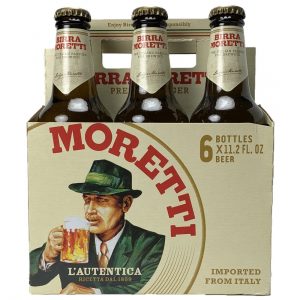
Example of bottled Moretti L’Autentica Lager exported to international markets.
ORIGINS
Birra Moretti was established in the northern Italian province of Friuli back in 1859 by local entrepreneur Luigi Moretti. Moretti built a brewery in the town of Udine which he originally called the “beer and ice factory”, and this is where Birra Moretti’s renowned lager was born (Birra Moretti, 2020).
Luigi Moretti was an interesting man. Moretti came from a family of wealthy merchants. Through his family connections Moretti had acquired a deep understanding of commerce and trade. The Moretti family had been actively exchanging wholesale foodstuffs including cereals, wine, spirits, and other foodstuffs. Moretti’s understanding and success in trading provided him with the entrepreneurial abilities needed to succeed in his new beer making venture (Birra Moretti, 2020).
The political landscape of the time played an important role in Moretti’s decision to establish a brewery in the Udine region. The late 1850’s and early 1860’s was a time of great political upheaval in Italian speaking regions of southern Europe. A movement for Italian unification was underway that was looking unite Italian peoples under one country. At the time, the Friuli region was under the administration of the Austro-Hungarian empire and there was a tremendous amount of contempt and disdain for Austrian rule (Craft Beer and Brewing, 2021).
Udine itself was a “small town not unfamiliar to rebellions, uprisings, and political unrest” and the town was home to numerous military camps during these times (Beer Life, 2021). The presence of these soldiers created a natural, sustainable demand for a locally produced beer.
Given that “Moretti purchased much of his beer from breweries within the Austro-Hungarian Empire, a regime most Italians reviled because they occupied much of northeastern Italy”, a locally produced beer seemed like a solid business venture for Moretti. (Craft Beer and Brewing, 2021). Moretti believed “it would be more profitable and patriotic to make his own beer” rather than continuing to obtain beer from Austria (Craft Beer and Brewing, 2021).Moretti concluded that a local produced beer would be a successful business venture and thus his “factory of beer and ice” in Udine was established (Craft Beer and Brewing, 2021).
KEY MILESTONES
The first bottle of Moretti beer from the Udine based brewery was sold locally in Friuli in the summer of 1860 (Birra Moretti, 2020) . The factory initially produced about 250,000 litres of beer a year which easily satisfied regional demand for the beer (For Beer Lovers, 2022). For the next century the beer produced at the “factory of beer and ice” in Udine was largely marketed regionally to the citizens of Friuli and Northern Italy (Birra Moretti, 2020). In fact, “Moretti’s brewery grew slowly, taking about 6 decades to double its output” (Craft Beer and Brewing, 2021).

Undated photo of Birra Moretti’s historic Udine brewery.
Birra Moretti remained a family run brewery with a focus on the regional market of northern Italy up until the late 1980’s (Birra Moretti, 2020). The family sold the brewery in 1989 (Nesbit & Nesbit, 2022). From the 1990’s onward “Birra Moretti went from being a Friuli-based beer to a nationally distributed beer, constantly growing and conquering new fans and admirers” (Birra Moretti, 2020).
This expansion had an impact on Birra Moretti’s production capabilities. By 1991 Birra Moretti was producing 100 million litres of beer and this output exceeded the production capabilities of the historic Udine brewery which closed in 1992 (Nesbit & Nesbit, 2022). The company built a newer, larger facility in San Giorgio di Nogaro, a town about 32km from Udine (Craft Beer and Brewing 2021).
In 1994, Moretti “entered into a partnership with Canadian brewer Labatt, which itself was purchased, a year later, by Belgian brewer Interbrew” (Craft Beer and Brewing, 2021). Moretti’s association with these brewers was not ideal and the company was acquired in 1996 by Heineken (Craft Beer and Brewing, 2021). Heineken’s acquisition of Birra Moretti led to a new focus on global distribution of the original pale lager. The company has also started to expand its product offering to include radlers, ales and lagers inspired by ingredients of specific Italian locales Beer lovers in over 40 countries around the world can enjoy Luigi Moretti’s original pale ale ad a variety of other more recent beer selections (Birra Moretti, 2020).
TIMELINE
1859: Luigi Moretti establishes “the beer and ice factory” in Udine, Friuli and Birra Moretti is born.
1860: First bottle of Birra Moretti is sold.
1989: Moretti family sells Birra Moretti marking end of family ownership.
1990: Birra Moretti expands from regional to national distribution.
1996: Birra Moretti purchased by Dutch brewer Heineken SV.
2001: Birra Moretti availability expands to international markets.
2006: Birra Moretti wins medals at Beer World Cup
2015: Launch of several new beers designed to capture culinary spirit of Italian regions.
BREWING SCIENCE AND INDUSTRIALIZATION
To understand the development of Birra Moretti lager it is important to look at the development of lager itself. The name “lager” originates from the German word meaning warehouse or storehouse (Brewcruizer, 2019). Lager is a relatively new beer style compared to ale which has been around for thousands of years. The first lager was produced in the 16th century in present day Germany (The Crafty Cask, 2021). Lager beer was born when brewers accidentally realized that storing beer in low temperatures using a cold-resistant yeast created a sharp tasting beer (The Crafty Cask, 2021). In the early years of lager brewing, the beer was stored in caves which provided the low temperatures needed for lager to properly ferment (Brewcruizer, 2019).
Given that lager needed to be stored in caves, the ability to produce lager on a large scale was limited. The industrial revolution created a seismic shift in beer brewing that benefitted lager producers. Industrialization led to the advent of refrigeration equipment that enabled lager brewers to produce lager beer more effectively and in larger quantities (The Crafty Cask, 2021). Refrigerators made it possible to brew beer at any time of the year which was crucial to the growth of lager’s availability. Refrigerators allowed brewers to store their lager in a cool environment until ready to be consumed (Brewcruizer, 2019). The refrigerator thus led to the growth in both the supply and the demand for lagers in the mid nineteenth century.
Luigi Moretti noticed that as lagers gained in popularity and in production, demand in Northern Italy for a quality locally produced lager was also growing. Technological advancements in refrigeration, modernized brewing processes and the availability of cold waters around Udine encouraged Moretti to establish his “beer and ice factory” in Udine (Birra Moretti, 2021).
Moretti’s brewing process for its original pale lager follows the modern process of lager brewing. To make Moretti Lager quality barley and hops are collected at their perfect point of ripeness. Barley is mixed with water and germinates to form a malt. Malt germination is halted and humidity is reduced during the drying stage. Significant heat is introduced during the roasting stage which determines the colour and flavour of the malt. The malt is then turned into flour. The malt flour is combined with water to produce wort. The wort is then cooked at 100 degrees Celsius and hops are introduced repeatedly. The wort is then cooled in a fermentation vat and yeast is added. The beer is left to cool and becomes clearer in complexion. The yeast residue is then removed from the brew during the flitration process. After filtered, Moretti’s lager beer is ready to be bottled and distributed for consumption (Birra Moretti, 2021).
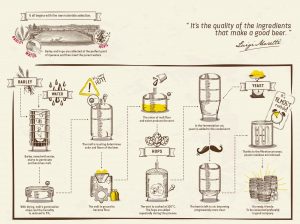 Illustration of Birra Moretti’s brewing process, a process largely unchanged since 1860.
Illustration of Birra Moretti’s brewing process, a process largely unchanged since 1860.
BEER STYLE
Most beer consumers believe lager to be of a premium quality. Lager beer is considered characterized by a richer and more natural taste relative to ales (Brewcruizer, 2019). Lagers are characterized by hoppy and fruity aromas and flavours, a pale colour and a clearer liquid than ales For Beers Lovers, 2020).
Lager’s unique style and flavour is the result of the type of yeast used in the fermentation process. The yeast used in lager brewing is Saccharomyces pastorianus, a variant of the Saccharomyces cerevisiae yeast used in the warm fermentation process that characterizes ale brewing. The yeast used in lagers ferments at low temperatures. While ale fermentation occurs at temperatures between 12 and 21 degrees Celsius lager fermentation occurs at lower temperatures of 3 to 10 degrees Celsius. Also, yeast ferments from the bottom in lager brewing as opposed to on the top with ale brewing. It is ultimately the type of yeast and the bottom fermenting that gives lager its unique characteristics (Brewcruizer, 2019)
The first bottle of Birra Moretti’s original lager was consumed in Udine in the summer of 1860. Moretti’s signature lager has been brewed using the same recipe, ingredients and process with few changes ever since. The beer is pale in colour with a 4.6 ABV and today is marketed as Birra Moretti L’Autentica (Birra Moretti, 2021).
Only the finest quality ingredients are used for the brewing of Birra Moretti’s L’Autentica lager. Luigi Moretti believed that it is the “quality of the ingredients that make a good beer”. Moretti’s L’Autentica lager is crafted using a timeless recipe that has remained almost unaltered to this day. Fresh water is coupled with the finest barley, malted hops and maize to create Moretti’s L’Autentica pale lager. One key to Moretti’s unique tasting lager is the use of a special blend of carefully selected hops. These hops produce a flavourful lager with pleasant hoppy and fruity notes. The final product is well a well-balanced signature lager with moderate bitterness and a natural, clean aftertaste with a 4.6 ABV (Birra Moretti, 2021).
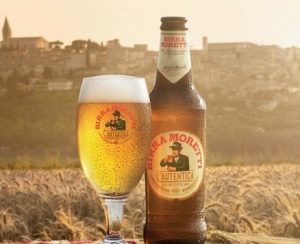
Moretti’s original lager in a glass showcasing the pale colour characteristic of lagers.
THE WWI and WWII ERA
Moretti’s brewery grew slowly during the first few decades of its existence. In 1860 the brewery was producing about 2,500 hl of beer, most of which was produced for local markets and local consumption (Craft Beer and Brewing, 2021). The original factory was able to handle this capacity as its market was the local beer bars of the province of Friuli (Alcorereviews, 2021). The end of World War I led to an economic boom in the 1920’s and Moretti’s pale lager was soon in high demand across Northern Italy. The increased popularity combined with economic prosperity allowed Birra Moretti to acquire additional land near its original factory and the company and new workshops were built (Alcoreviews, 2021). By 1921 Moretti’s Udine brewery was producing about 32,000 hectolitres of beer annually (Craft Beer and Brewing, 2021).
Birra Moretti’s positive sales growth provided the brewery with financial security that allowed it to remain competitive through the economic depression of the 1930’s as well as through World War II (Craft Beer and Brewing, 2021). During the Second World War much of Moretti’s brewing facilities were destroyed during the fighting but the owners managed to restart production as the war ended (Alcoreviews, 2021). While post war reconstruction and economic growth did not propel Birra Moretti to expand globally overnight, their ability to withstand the challenging first half of the century was crucial to its future. The company was able to continue to grow at a reasonable pace in the short term and its beer was became increasingly available and appreciated across Italy. This was the result of rebuilding after the war and also due to the repair and modernization of transportation networks across Italy. By the early 1990’s, Birra Moretti had grown into a truly national brewery and brand, surpassing 1 million hl of beer brewed in 1991 (Craft Beer and Brewing, 2021).
CONSOLIDATION
The post war economic boom and advancements in science and technology during the mid 20th century led to the emergence of a society based on consumerism and consumption in Western countries. The emerging middle class wanted to spend their new wealth on consumer products associated with living the good life. Many breweries benefitted from this focus on consumerism and saw their operations increase significantly as a result of increased demand for their beer during these prosperous times.
In the first decade following WWII, Birra Moretti remained a locally focused brewery with distribution focused on Northern Italy. The Moretti family continued to own the brand and operate their Udine brewery directly. Birra Moretti gradually expanded its distribution across Italy as the second half of the 20th century progressed. Successful marketing and branding strategies throughout the 1960’s and 1970’s increased the visibility and reputation of Birra Moretti across Italy, resulting in increased demand and respect for the Birra Moretti brand nationwide (Birra Moretti, 2020).
In the 1980’s and 1990’s many breweries around the world began consolidating. An increasing number of smaller, local and national breweries were being bought out by large foreign beer companies and consortiums. Globalization was making people more aware of foreign beer which created a global demand for foreign beers. Consumers increasingly sought out mysterious and exotic foreign beers and it was trendy to consume foreign beers. Distribution of beer internationally was easier for large conglomerates than it was for small regional breweries. In light of these trends, the Moretti family decided to sell the Birra Moretti brewery and brand to a consortium of brewers in 1989, approximately 140 years after Luigi Moretti originally founded the brewery (Birra Moretti, 2020).
In 1991, Birra Moretti surpassed 1 million hectalitres of beer production for the first time. The Udine plant was operating at capacity and to accommodate increased production, Birra Moretti opened a new facility in nearby San Giorgio di Nogaro in 1992. Birra Moretti’s increased size and significant growth potential in the early 1990’s made it an attractive target for a take-over by a large foreign brewery. The Birra Moretti owners explored partnerships with other brewers and in the early 1990’s Birra Moretti entered into a partnership with Canada’s Labatt which was then bought out by Beligan brewer Interbrew. As the decade progressed it became apparent that the arrangement was not the right fit for the Birra Moretti brand (Craft Beer and Brewing, 2021).
In 1996 Dutch beer giant Heineken bought Birra Moretti (For Beers Lovers, 2022). As of 2022 Heineken maintains its ownership and production of Birra Moretti. Heineken has overseen Birra Moretti’s growth from an Italian beer into an internationally renowned brand. Birra Moretti products, led by its mainstay pilsner style L’Autentica lager, can now be found in over 40 countries world-wide including the United States, Canada, the United Kingdom and Japan (Craft Beer and Brewing, 2021).
MARKETING AND BRANDING
Birra Moretti has established a timeless and recognizable logo for its beer. Since the early 1950’s, the brand has been represented by a logo known as the “mustached man”. The iconic logo “features a portrait of a mustachioed man blowing foam from a full mug” of Moretti beer (Alcoreviews, 2021).
Birra Morretti’s legend claims that, in 1942, Luigi Moretti’s nephew visited the Trattoria Boschetti in Udine where he noticed a mustached man sitting at a table enjoying his Moretti beer. The nephew was intrigued and asked the man if he could take a picture of him drinking his beer. The man agreed in exchange for another glass of Moretti beer. The photo taken of this “mustached man” became the logo for Moretti beer. (Birra Moretti, 2020).
Other origin stories have developed over time. Some claim that the man in the picture is a Tyrolean farmer, taken by Erika Groth–Schmachtenberger in 1939 during a visit to Northern Italy (Beer Life, 2021). Some claim that in 1957 Birra Moretti recognized Groth-Schmachtenberger as the true author of the photo (Passamonte, 2021). All rights to the photo were apparently ceded by Groth to Birra Moretti by the photographer in exchange for 37,200 lira (Passamonte, 2021). Regardless of the true origin of the photo, the “mustached man” has undoubtedly been the face of Birra Moretti since early 1950’s.
The “mustached man” was a perfect logo for Birra Moretti beer. The man reflected the “real values of his beer: authenticity, tradition and genuineness”( Birra Moretti, 2020). The image of the “mustached man” that appears on every single Birra Moretti label “reminds us of where we come from and who we brew our beer for” (Birra Moretti, 2020). The logo perfectly complements Birra Moretti’s brand strategy as a traditional lager that is authentic and genuine in its preparation and in taste.
The “mustached man” logo has become iconic due to its relatability. Many people see themselves in the honourable and identifiable gentleman who graces Birra Moretti bottles and advertisements (Birra Moretti, 2020). “It was so commonplace and relatable that the icon seems to be inviting everyone to enjoy a pint while getting business done” (Beer Life, 2021). The success of the logo influenced advertising practices, specifically the trend of using real and relatable people in advertisements (Beer Life, 2021).
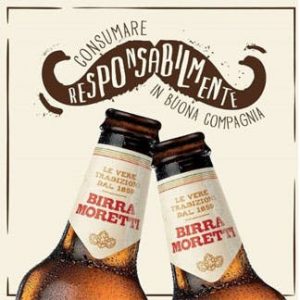
Use of famous mustache in Italian Birra Moretti advertisement.
Throughout the years the “mustached man” has appeared in various Birra Moretti advertisements. Famous Italian actors have been hired to portray the “mustached man” in television commercials. In the 1970’s, renowned Italian artist Bruno Bozetto was commissioned to develop Birra Moretti cartoon advertisements. These cartoon advertisements that depicted the mustached man and his glass of Moretti beer proved very popular and increased brand recognition across Italy (Birra Moretti, 2020).
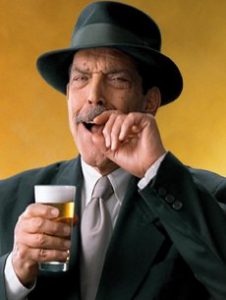
Orso Maria Guerrini: Italian Actor appeared in Birra Moretti TV commercials between 2001 and 2016.
Today, the “mustached man” logo is recognized internationally. The original logo has been so successful in representing Birra Moretti that there have been only minor changes to the logo since its inception over 70 years ago. While other beers have rebranded as times change, Birra Moretti has been able to maintain its iconic look because of the positive connections that resonate with consumers.

Pier Maria Checchini: Italian actor and current “Mustached Man” in Birra Moretti television advertisements.
MODERN ERA
The preferences of beer consumers have become unique and personalized and this has resulted in a complex beer market characterized by specialized product offerings. Beer drinkers around the world are increasingly turning away from traditional, mass marketed beers and instead are seeking out unique and sophisticated beer products that connect with their own personal preferences. The growth of the craft beer industry has caused beer makers like Birra Moretti to diversify their product offerings and to try to create unique beers that connect with the personality of their customers.
After decades of producing its traditional L’Autentica pilsner styled lager almost exclusively, Birra Moretti has introduced a variety of new products designed to appeal to consumers looking for a unique beer experience while still meeting high quality and flavour expectations. Birra Moretti now offers a series of IPA’s, Weiss and Bocks that are meant to appeal to beer drinkers that are looking for a more distinct flavour profile than what Birra Moretti’s pilsner and lagers traditionally offered. A series of reserve beers have also been introduced for customers seeking a premium beer product that is considered rare and upper class (Amato, 2021).
For beer drinkers that are attracted to local ingredients and flavours, Birra Moretti has introduced a series of regionally inspired brews that use ingredients from Sicily and Tuscany. The Sicilian offering uses orange blossoms native to Sicily to create a beer with a bitter, flora flavour. The Tuscan offering uses a local barley from Maremma that gives this regionally inspired brew strong and weel rounded flavour with a chestnut accent (Amato, 2021).
Another current trend in beer consumption is the increasing emphasis on responsible drinking. The World Health Organization is committed to reducing alcohol consumption in every country by 10% by the year 2025. In the last decade Birra Moretti increased production of low alcohol and zero alcohol beers to serve the growing demand for healthier beer options. In 2014, Birra Moretti introduced a Radler Beer that is a mixture of Moretti lager and Sicilian lemon juice. The alcoholic content of Birra Moretti Radler is 2% which is significantly lower than the alcohol content of its other brews. The popularity of the original Radler has led Moretti to offer an alcohol free Radler called “Moretti Lemon Zero”. Birra Moretti also offers a non-alcoholic brew called “Zero” that still embodies many of the pleasant and refreshing flavours found in its L’Autentica beer. These product offerings are a direct result to the changing appetite amongst consumers and the increased demand for low and zero alcohol beer options (Amato, 2022).
KNOWLEDGE CHECKS
[h5p id=”1847″]
IMAGES:
Logo: https://en.wikipedia.org/wiki/Birra_Moretti#/media/File:Birra_Moretti_Logo_2015.jpeg
Bottled Beer: https://www.colonialspirits.com/product/birra-moretti-6-pack/
Udine Factory: https://www.cronachedibirra.it/birrifici/20755/gli-storici-marchi-di-birra-italiani-parte-iii-moretti-poretti-spluga-forst-messina/
Moretti Lager Brewing Process: https://www.birramoretti.com/global/en/art-of-brewing
American Lager and Ingredients: https://learn.kegerator.com/how-to-brew-american-lager/
Mustache in Italian Advertisement: https://www.marketingweek.com/heineken-birra-moretti-tv-ad/
Orso Maria Guerrini: http://www.ilovebeer.it/it/2011/09/orso-maria-guerrini-%E2%80%9Cbirra-s%C3%AC-ma-con-moderazione%E2%80%9D
Pier Maria Checchini: https://www.tusciaup.com/un-baffo-moretti-piermaria-cecchini-testimonial-della-birra/73455
REFERENCES
Alcoreviews: Birra Moretti. (2021, August 31). Retrieved March 10, 2022, from https://alcoreviews.com/birra-moretti-birra-moretti/
Aloyants, V. (2020, September 23). information about Moretti Beer. The Best Beer Website For Beers Lovers. Retrieved February 4, 2022, from https://www.forbeerslovers.com/en/information-about-moretti-beer
Amato, M. (2022, March 24). Moretti Beer: The tasty Italian beer appreciated worldwide. Bell Italia. Retrieved April 10, 2022, from https://www.bell-italia.com/blog/en/food/moretti-beer-the-tasty-italian-beer-appreciated-worldwide
Beerlifeofficial. (2021, April 19). Beerlifeofficial. BeerLife Sports. Retrieved February 4, 2022, from https://beerlife.com/history-behind-the-making-of-the-iconic-birra-moretti/
Birra Moretti. (2020). Retrieved February 3, 2022, from https://www.birramoretti.com/global/en/homepage
Birra Moretti La Rossa. This Drinking Life. Retrieved February 7, 2022, from https://www.thisdrinkinglife.com/birra-moretti-la-rossa/
De Nicola, M. (2017, March 28). Con Il nuovo spot Cambia il Baffo di Birra Moretti. beverfood.com. Retrieved April 10, 2022, from https://www.beverfood.com/con-il-nuovo-spot-cambia-il-baffo-di-birra-moretti-wd80683/
Fleming, M. (2018, July 18). Heineken’s Birra Moretti launches first TV ad in the UK. Marketing Week. Retrieved April 10, 2022, from https://www.marketingweek.com/heineken-birra-moretti-tv-ad/
Lager beer explained: 9 essential facts, figures and serving tips. The Crafty Cask. (2021, August 23). Retrieved March 10, 2022, from https://thecraftycask.com/craft-beer/lager-beer-explained-9-essential-facts-figures-and-serving-tips/Nesbit, R., & Nesbit, R. (2022, January 25).
Lager: Characteristics and types. The Best Beer Website 🍻 | For Beers Lovers. (2020, August 19). Retrieved March 13, 2022, from https://www.forbeerslovers.com/en/lager-characteristics-and-types
Passamonte, S., & Info autore Salvatore Passamonte Sono nato a Catania nel ’94. (2021, January 13). Stefano Buiatti Ricostruisce la Vera Storia del Baffone della Birra Moretti. Giornale della Birra. Retrieved April 10, 2022, from https://www.giornaledellabirra.it/storia-di-birra/stefano-buiatti-ricostruisce-la-vera-storia-del-baffone-della-birra-moretti/
The history and fermentation process of lager beer. BrewCruizer. (2019, October 30). Retrieved March 9, 2022, from https://brewcruizer.com/beer-blog/the-history-and-fermentation-process-of-lager-beer.html
The Oxford companion to beer definition of Moretti Brewery. Craft Beer & Brewing. (2021). Retrieved February 5, 2022, from https://beerandbrewing.com/dictionary/2jPpIBNMCf/

